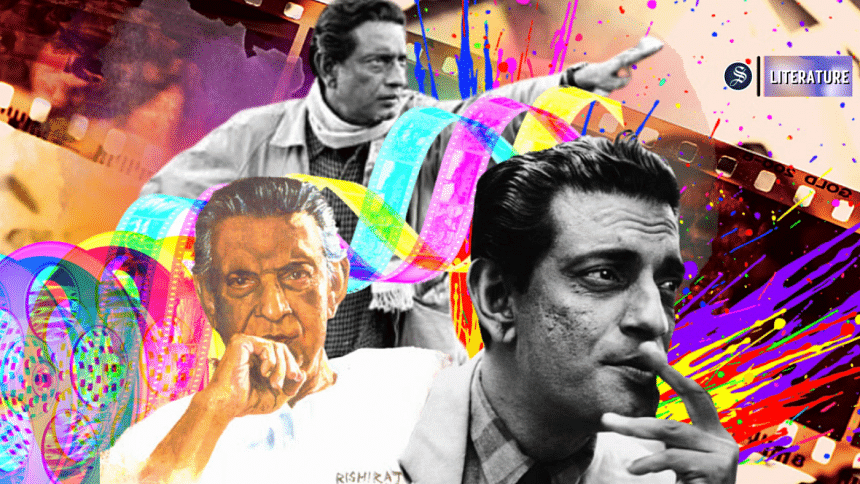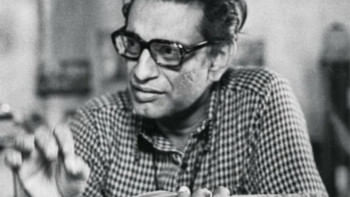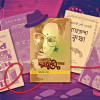Chronicling the ’70s through Satyajit Ray

A semblance of corruption or revolution, two extremes, made Somnath's father anxious in Jana Aranya (The Middleman, 1975): "The unemployed youth have only two choices left, either corruption or revolution!" This was his remark, discerning the youth of Calcutta standing at the crossroads in the '70s. Calcutta, a lively city though, was brimming with refugees, immigrants and a chunk of unemployed youth. In the words of Vincent Canby, "Too many people, too little space," as he wrote in The New York Times, while reviewing Ray's Jana Aranya.
The detonations in the 70s—a manifestation of social complexities, accumulated over time—reflected sharply in Satyajit Ray's Calcutta trilogy. The edgy connotations of the three films mirrors Ray's profound understanding of the dialectics and makes him germane and a 'socially-important' artist (as propounded by Cesare Zavattini in his essay, "Some ideas on Cinema": "If the gold-diggers come at last to dig in the illimitable mine of reality, the cinema will become socially important") even in 21st century West Bengal, which has become a circular ruin of unemployment, exploitation, and political corruption. A thematic breakdown of the trilogy might lead us to discern two things: the relevance of the three films and the osmosis of ideas in Satyajit Ray's mind, who was not sure in 1970, while working on Pratidwandi (1970), that he would end up making a trilogy by 1975.
In 1969, Charu Mazumdar had proclaimed in "Deshabrati": "China's chairman is our chairman, China's path is our path." Naturally, when Ray was filming Pratidwandi, the movement was in full force—one must not miss the widely spread slogans and Mao's face on the walls in the fleeting moments of the final flash-forward scene, accompanied by an anxious piece of music. Pratidwandi is a film that can be treated as a document of an artist who foresaw the loose ends of the Naxalite movement. Ray's depiction of Shiddhartha's character makes us ponder on the weak organisational aspect of the Naxalite movement, as the movement failed to secure a long term commitment from him.
Siddhartha drops out from medical college after losing his father, and spends his days and nights in search of a job. Morally, he stands at the crossroads between his sister, Sutapa, and brother, Tunu. Sutapa, the sole breadwinner of the family, is less worried about the speculations hovering around her. Tunu, on the other hand, is a radical communist who was committed to his organisation more than anything else. Siddhartha, who once sold his medicine books to present Tunu with Che Guevara's The Complete Bolivian Diaries, now does not seem as committed to the movement as he should be. He is, as remarked by one of his friends, mostly a thinker, not a doer. He thinks of firing a bullet at Sutapa's boss's ribs, of charging a driver accused of hitting a child on the street—but refrains in both cases. All this rage piling up inside Siddhartha, bursts out in the climax scene when he upturns a table, hurls a chair, and shouts at the interviewers: "Are we animals?"
Seemabaddha (1971) chronicles the tale of Shyamalendu's life, portraying the other side of Calcutta, where people are not exploited, and instead have taken the position of exploiting others. Shyamalendu, the protagonist, is an ambitious employee at Hindushthan-Peters Ltd. He has a tinge of empathy for the guerrilla fighters in his heart. In a sherry party, he tries to defend them by saying their problems are universal, only to hear shortly: "Universal, my foot!" from one of his colleagues. This unkind bourgeois milieu where Shyamalendu resides infects him too, and leads him to exploit the factory-workers in order to secure his promotion in the company. Ray's sharp critique of his dwindling humanity lies in the unperturbed faces and the dialogues between Shyamalendu and his company as they profit from the staged workers strike at the factory.
In contrast with Pratidwandi, the staunchness from the Naxalite movement vanishes in Jana Aranya. In a match cut, Mao's face and CPI(ML) slogans written on the wall are smeared with ink, and the students, losing their moral conscience, cheat in front of their professor in the examinations. Somnath, the protagonist—unlike Siddhartha—gives up applying for a job and decides to set up his own business. For the first time in the entire trilogy, a protagonist makes up his mind to engage himself in business, an unusual decision for an educated Bangali, even today. The business environment of the middlemen soon disgusts Somnath, but unlike Siddhartha and Shyamalendu, he learns to accept the odds in order to make his living. What more can we accept from a decaying time and its youth? Jana Aranya reveals the degeneration of the movement and the values that lacked their root from the beginning.
Ray might not have done this intentionally, but the wristwatch has become a common thread throughout the three films, a recurring motif that connects them thematically. Siddhartha in Pratidwandi takes his broken wristwatch to the mechanic, but his pocket doesn't allow him to pay the money required for the repairs. In the next sequence, he gazes at a woman's breasts and instead of feeling temptation, he thinks of his college days. In a flashback, Siddhartha recalls a lecture he had heard on the anatomy of the female breast in medical college. Does this sequence want us to understand the good days are gone from Siddhartha's life?
In Seemabaddha, Shyamalendu lends an expensive wristwatch to Tutul, his sister-in-law. Having seen Tutul after years, Shyamalendu is captivated by her beauty and playfully flirts with her whenever he gets the chance. But in the final sequence, when Tutul cuts all ties with Shyamalemdu, although metaphorically, by returning back his wristwatch, he suffers a sense of loss even after climbing up the tiring ladder of success.
Finally, Somnath receives a wristwatch from his sister-in-law in Jana Aranya, but in the very next sequence, his fiancee leaves him to marry someone else. Somnath mocks his sister-in-law by saying, "Your watch is giving me a really good time." But time certainly changes for Somnath. He secures orders in his business, rips up his former lover's letter (contrary to Siddhartha and Shyamalendu's character) and moves on. But in reality, Somnath moves on from his values and ethics. Later in the film, he finds himself in a position where he had done something for money, which he cannot even explain to his family. The connotation of time here doesn't only indicate an individual's decline from morality, but a collective degeneration of ethics and values.
Ray used sexuality—still a taboo—in his early films metaphorically, to bring poetic enchantment rather than arouse sexual impulse. However, contrary to these early films, Ray's portrayals of sexual impulse and tension are quite explicit in the Calcutta trilogy. Siddhartha's concern regarding his sister's intimacy with her boss and asking her to quit her job, as well as the sequence where he hesitates to light a nurse's cigarette, questions his progressiveness. Siddhartha's irritation and hesitation surrounding sex reflects that he has still not freed himself from the puritanical chains of Bhadralok ideas.
However, Shyamalendu dwells in an altogether different social strata, where flirting with women is not seen as a sin. In Seemabaddha, Shyamalendu every so often gets intimate, in a platonic manner, with Tutul. He skips his Sunday golf session to spend time with her and, in the end, despairs when Tutul returns the wristwatch, as if his world has fallen apart. But the subdued sexual imagery of Seemabaddha transforms into a stark reality in Jana Aranya, where girls from needy families sell their bodies to earn bread. In this last segment of the trilogy, Somnath coincidentally bumps into Kauna—his friend's sister—and discovers that she has adopted the name "Juthika", and has been involved in prostitution for three months. Somnath, unwilling though he is, accepts his fate and delivers Kauna to Mr Goenka, securing a deal in return.
To conclude, I must say that the trilogy has withstood the test of time and seems relevant to us even today, perhaps because Satyajit Ray was keen to ask questions rather than suggest a solution to the audience—a neorealist trait, of course. According to Zavattini, "Neorealism does not offer solutions. The end of a neorealist film is particularly inconclusive." However, one must not think that Ray followed Italian neorealism; there were fundamental differences. His inconclusiveness offers a certain space for the audience that evades the shackles of time and stays relevant to us as long as we have faith in them. So, in order to understand today's dialectics, we must go back to those offered spaces and engage ourselves with the questions Ray had propounded.
Soumalya Chatterjee, from India, is a former student of Comparative Literature at Jadavpur University.

 For all latest news, follow The Daily Star's Google News channel.
For all latest news, follow The Daily Star's Google News channel. 









Comments